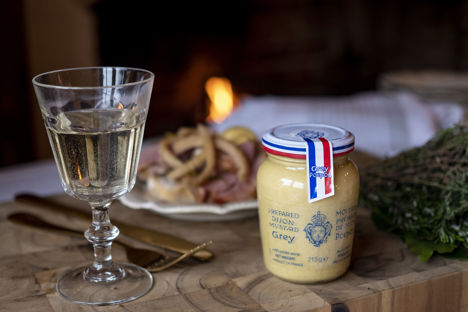
Grey Poupon: the mustard made for cooking
Ever since the first jar was created in 1866, Grey Poupon has been the undisputed king of mustards. Read on as we explore why Grey Poupon has always been the connoisseur’s choice, before delving into some classic mustard-flecked dishes.
Grey Poupon: the mustard made for cooking
Ever since the first jar was created in 1866, Grey Poupon has been the undisputed king of mustards. Read on as we explore why Grey Poupon has always been the connoisseur’s choice, before delving into some classic mustard-flecked dishes.
Sit down for a meal at any table in France and you’ll likely find a jar of mustard on the table. This is a country where mustard is given equal billing with salt and pepper – it’s an essential condiment to be liberally slathered in baguettes, brushed over meat and fish, whisked into salad dressings and melted into sauces. The prickly heat of mustard characterises all sorts of classic French dishes, from rabbit with mustard sauce to Croque Monsieur. French cookery simply wouldn’t be the same without it.
The French love affair with mustard goes back almost a thousand years – it is said that the Romans first introduced mustard to Gaul, as it was then, but French moutardiers have been making mustard in Dijon since the thirteenth century. Dijon, of course, is the epicentre of the mustard world – a capital of French gastronomic culture that boasts not only the best mustard in existence but also some of its very finest vineyards. Mustard plants and vines live together very happily; mustard is grown as a cover crop in Burgundy, managing the soil and nutrients in between grape harvests.
Rather than the bright yellow of American or English mustard, Dijon has a pale complexion that belies its potency – it may look gentle but it packs a hefty, nose-tingling punch of heat that lifts the lid off any dish. And while the generic 'Dijon' term given to this kind of mustard gives you an idea of how it will taste, there is one particular jar we have always looked for on the shelves – Grey Poupon.
Grey Poupon has been the choice of the mustard connoisseur for centuries now, thanks mostly to the fact that it's made with white wine (rather than the much more common vinegar), which results in a much more complex, rounded flavour. In the early days, all mustard came ‘a l’ancienne’, where the mustard seeds were ground to a rough paste with local vinegar, but when an English woman called Mrs Clements began milling mustard seeds into powder to make mustard, the moutardiers of Dijon adopted a similar process. Mustard seeds were milled by hand for many years in Dijon until a moutardier called Maurice Grey invented a steam-powered mill that could crush the seeds down to a fine powder in a fraction of the time.
Maurice was awarded two medals for his mustard machine in 1855, and by 1860 he was awarded a Royal Appointment to further develop his invention (proving just how much the French love mustard). Finding himself in need of funding to carry out the Royal Appointment, Maurice formed a partnership with Auguste Poupon – another renowned moutardier of Dijon. Together, the pair formed Grey Poupon in 1866.
Over the next 200 years, Grey Poupon would change the landscape of French food. Whilst most other moutardiers of the time combined mustard seeds with vinegar and verjus, Grey Poupon blended its mustard with white wine – white Burgundy no less – which gave the mustard a slightly less pungent, more rounded flavour. That distinct flavour made Grey Poupon a favourite with chefs and cooks in particular, who found that it brought an extra dimension to sauces, soups, salad dressings and more. By the 1980s, Grey Poupon was a household name – the clear, unambiguous choice for anyone who knew anything about mustard. The brand’s high-end, luxurious reputation means it’s been referenced in hip-hop and rap lyrics in the decades since – making it a little like the cognac of the mustard world.
As for what you can do with it, well, the possibilities stretch far and wide. Whisking a teaspoon of Grey Poupon mustard into a vinaigrette, a sauce or mayonnaise is a quick and effective way of introducing some sharpness and piquancy into a dish – check out Martin Wishart’s Puy lentils with Dijon mustard vinaigrette to see what we mean. Mustard is naturally high in an emulsifier called lecithin, so it also helps to bind emulsions and give them a nice smooth consistency. Our Poulet à la moutarde dish is a classic example of how Dijon mustard elevates French cookery, with chicken legs braised in a mustard sauce that is creamy and soothing, but spiked with prickly heat, as are these creamy Dijon mushrooms with toasted brioche.
Mustard and meat has always been a popular combination too, likely because the sharp tang of the mustard accentuates strong, salty, meaty flavours. You can spread mustard in a sandwich or squeeze it over a hot dog, sure, but the flavours are even more effective when you introduce Dijon to the cooking process. In our Apricot and wholegrain mustard-glazed ham, a whole-roasted ham is brushed with a fruity mustard glaze, giving it an incredible sweet, sharp, spicy flavour.
However you decide to use it, it goes without saying that Dijon mustard should be right at the top of a list of kitchen cupboard essentials, and if you’re after the best, Grey Poupon is the mustard to go for.

